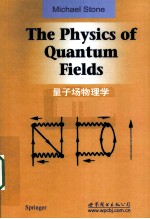

量子场物理学 英文版PDF电子书下载
- 电子书积分:11 积分如何计算积分?
- 作 者:(美)斯通著
- 出 版 社:北京/西安:世界图书出版公司
- 出版年份:2010
- ISBN:9787506292764
- 页数:271 页
1 Discrete Systems 1
1.1 One-Dimensional Harmonic Crystal 1
1.1.1 Normal Modes 1
1.1.2 Harmonic Oscillator 4
1.1.3 Annihilation and Creation Operators for Normal Modes 5
1.2 Continuum Limit 7
1.2.1 Sums and Integrals 7
1.2.2 Continuum Fields 8
2 Relativistic Scalar Fields 12
2.1 Conventions 12
2.2 The Klein-Gordon Equation 13
2.2.1 Relativistic Normalization 14
2.2.2 An Inner Product 16
2.2.3 Complex Scalar Fields 17
2.3 Symmetries and Noether's Theorem 18
2.3.1 Internal Symmetries 18
2.3.2 Space-Time Symmetries 21
3 Perturbation Theory 25
3.1 Interactions 25
3.2 Perturbation Theory 26
3.2.1 Interaction Picture 26
3.2.2 Propagators and Time-Ordered Products 27
3.3 Wick's Theorem 30
3.3.1 Normal Products 30
3.3.2 Wick's Theorem 30
3.3.3 Applications 32
4 FeynmanRules 37
4.1 Diagrams 37
4.1.1 Diagrams in Space-time 37
4.1.2 Diagrams in Momentum Space 41
4.2 Scattering Theory 43
4.2.1 Cross-Sections 44
4.2.2 Decay of an Unstable Particle 47
5 Loops,Unitarity,and Analyticity 48
5.1 Unitarity of the S Matrix 48
5.2 The Analytic S Matrix 51
5.2.1 Origin of Analyticity 51
5.2.2 Unitarity and Branch Cuts 52
5.2.3 Resonances,Widths,and Lifetimes 54
5.3 Some Loop Diagrams 56
5.3.1 Wick Rotation 56
5.3.2 Feynman Parameters 58
5.3.3 Dimensional Regularization 59
6 Formal Developments 62
6.1 Gell-Mann Low Theorem 62
6.2 Lehmann-K?llén Spectral Representation 64
6.3 LSZ Reduction Formulae 67
6.3.1 Amputation of External Legs 67
6.3.2 In and Out States and Fields 68
6.3.3 Borcher's Classes 71
7 Fermions 72
7.1 Dirac Equation 72
7.2 Spinors,Tensors,and Currents 74
7.2.1 Field Bilinears 74
7.2.2 Conservation Laws 75
7.3 Holes and the Dirac Sea 75
7.3.1 Positive and Negative Energies 75
7.3.2 Holes 78
7.4 Quantization 79
7.4.1 Normal and Time-Ordered Products 81
8 QED 83
8.1 Quantizing Maxwell's Equations 83
8.1.1 Hamiltonian Formalism 83
8.1.2 Axial Gauge 84
8.1.3 Lorentz Gauge 85
8.2 Feynman Rules for QED 88
8.2.1 M?ller Scattering 90
8.3 Ward Identity and Gauge Invariance 92
8.3.1 The Ward Identity 92
8.3.2 Applications 93
9 Electrons in Solids 97
9.1 Second Quantization 97
9.2 Fermi Gas and Fermi Liquid 100
9.2.1 One-Particle Density Matrix 100
9.2.2 Linear Response 103
9.2.3 Diagram Approach 104
9.2.4 Applications 106
9.3 Electrons and Phonons 114
10 Nonrelativistic Bosons 117
10.1 The Boson Field 117
10.2 Spontaneous Symmetry Breaking 118
10.3 Dilute Bose Gas 122
10.3.1 Bogoliubov Transfomation 122
10.3.2 Field Equations 125
10.3.3 Quantization 126
10.3.4 Landau Criterion for Superfluidity 128
10.3.5 Normal and Superfluid Densities 129
10.4 Charged Bosons 131
10.4.1 Gross-Pitaevskii Equation 131
10.4.2 Vortices 132
10.4.3 Connection with Fluid Mechanics 134
11 Finite Temperature 136
11.1 Partition Functions 136
11.2 Worldlines 137
11.3 Matsubara Sums 140
12 Path Integrals 143
12.1 Quantum Mechanics of a Particle 143
12.1.1 Real Time 143
12.1.2 Euclidean Time 146
12.2 Gauge Invariance and Operator Ordering 148
12.3 Correlation Functions 150
12.4 Fields 152
12.5 Gaussian Integrals and Free Fields 153
12.5.1 Real Fields 153
12.5.2 Complex Fields 155
12.6 Perturbation Theory 156
13 Functional Methods 158
13.1 Generating Functionals 158
13.1.1 Effective Action 161
13.2 Ward Identities 166
13.2.1 Goldstone's Theorem 167
14 Path Integrals for Fermions 171
14.1 Berezin Integrals 171
14.1.1 A Simple Supersymmetry 174
14.2 Fermionic Coherent States 177
14.3 Superconductors 179
14.3.1 Effective Action 181
15 Lattice Field Theory 185
15.1 Boson Fields 185
15.2 Random Walks 189
15.3 Interactions and Bose Condensation 191
15.3.1 Rotational Invariance 192
15.4 Lattice Fermions 195
15.4.1 No Chiral Lattice Fermions 200
16 The Renormalization Group 201
16.1 Transfer Matrices 202
16.1.1 Continuum Limit 204
16.1.2 Two-Dimensional Ising Model 205
16.2 Block Spins and Renormalization Group 206
16.2.1 Correlation Functions 212
17 Fields and Renormalization 213
17.1 The Free-Field Fixed Point 213
17.2 The Gaussian Model 215
17.3 General Method 219
17.4 Nonlinear σ Model 220
17.4.1 Renormalizing 225
17.4.2 Solution of the RGE 228
17.5 Renormalizing λ?4 229
18 Large N Expansions 233
18.1 O(N) Linear σ-Model 233
18.2 Large N Expansions 237
18.2.1 Linear vs.Nonlinear σ-Models 241
A Relativistic State Normalization 246
B The General Commutator 248
C Dimensional Regularization 250
C.1 Analytic Continuation and Integrals 250
C.2 Propagators 252
D Spinors and the Principle of the Sextant 254
D.1 Constructing the γ-Matrices 254
D.2 Basic Theorem 255
D.3 Chirality 256
D.4 Spin(2N),Pin(2N),and SU(N)?SO(2N) 257
E Indefinite Metric 258
F Phonons and Momentum 261
G Determinants in Quantum Mechanics 264
Index 267
- 《卓有成效的管理者 中英文双语版》(美)彼得·德鲁克许是祥译;那国毅审校 2019
- 《新编高中物理竞赛教程习题全解》钟小平主编;钟小平,倪国富,曹海奇编写 2019
- 《数学物理方法与仿真 第3版》杨华军 2020
- 《中学物理奥赛辅导:热学 光学 近代物理学》崔宏滨 2012
- 《长江口物理、化学与生态环境调查图集》于非 2019
- 《大学物理简明教程 下 第2版》施卫主编 2020
- 《慢性呼吸系统疾病物理治疗工作手册》(荷)瑞克·考斯林克(RikGosselink) 2020
- 《医学物理学》洪洋 2020
- 《初中物理知识地图》赵端旭 2017
- 《AutoCAD 2018自学视频教程 标准版 中文版》CAD/CAM/CAE技术联盟 2019
- 《TED说话的力量 世界优秀演讲者的口才秘诀》(坦桑)阿卡什·P.卡里亚著 2019
- 《小手画出大世界 恐龙世界》登亚编绘 2008
- 《近代世界史文献丛编 19》王强主编 2017
- 《课堂上听不到的历史传奇 世界政治军事名人 初中版》顾跃忠等编著 2015
- 《指向核心素养 北京十一学校名师教学设计 英语 七年级 上 配人教版》周志英总主编 2019
- 《365奇趣英语乐园 世界民间故事》爱思得图书国际企业 2018
- 《近代世界史文献丛编 36》王强主编 2017
- 《北京生态环境保护》《北京环境保护丛书》编委会编著 2018
- 《近代世界史文献丛编 11》王强主编 2017
- 《近代世界史文献丛编 18》王强主编 2017
